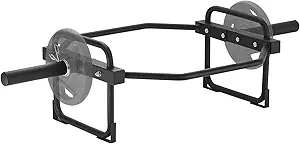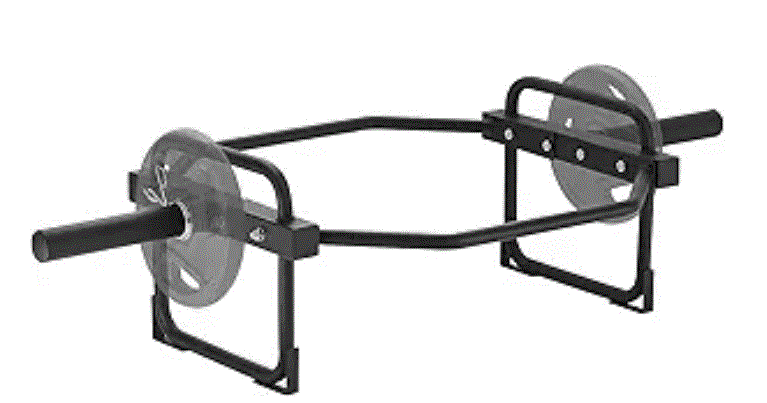The safety bar squat is also called the “safety squat bar SSB squat.” It is a special version of returned squat, which recently gained quite popularity among powerlifters, bodybuilders, and all interested in athletics. Its benefits are various: more mechanics, more comfort, and smaller injury chances. For many, it becomes an essential addition to any training routine, with particular importance for those with problems in the shoulders, wrist, or the lower back.
This article will familiarize you with every aspect of a safety bar squat-from its benefits to how to do it, the mass of muscles used, and practicability as a priceless alternative to other variations of squats. You are either a novice or advanced gym-goer in any case, learning how to execute the safety bar squat surely gives flair to your coaching routine.
What is a Safety Bar Squat?
A protection bar squat will be performed with a special barbell known as a safety squat bar (SSB). This is quite different from a standard barbell in that it has padded shoulder pads and handles protruding forward. This should position his hands in front of the lifter so he doesn’t have to reach around to his own back for the bar as with a traditional back squat. The bar also has a slight camber, or curve, which impacts the movement by slightly forward-shifting the center of gravity.
This design is specifically very accommodating for people with restricted shoulder or wrist mobility because it nearly completely eliminates the need to rotate arms out and back while hanging the barbell behind the neck. Also, the curved shape of the bar invites a more vertical torso position, which will be useful in relieving pressure off the lower back.

Benefits of Safety Bar Squat
Better Posture and Form The curve of the protection bar allows the lifter to maintain a better erect posture throughout the squat. In regular turned back squats, lifters tend to lean forward too far, creating unwanted stresses on the lower back. The forward pitch of the protection bar generates correct form, resulting in an even greater advantageous squat with much less chance of risk of injury.
The main benefit of a safety bar squat is that it completely eliminates shoulder and wrist stress. Traditional squats demand such great shoulder mobility to keep the bar on the back of the neck, which can be very stressful for men and women having tight shoulders or having any injury history in the past. The ahead hand controls of the SSB are designed to ensure that the lifter keeps his or her arms in a neutral position to avoid discomfort and straining.
Lower Back Safety
The safety bar slight forward lean redistributes part of the load from the lower lower back to the quadriceps. Therefore, the squat on a safety bar is an excellent exercise for the athlete recovering from lower lower back injuries or those sensitive to lower lower back discomfort; it enables them to continue squatting without overstretching the lumbar spine.
More quadriceps activation
Since the weight cannot move much forward due to the design of the safety bar, the quads are thus more stressed. It makes protection bar squat an excellent choice for those training to build their quads or take their squat depth deeper. That will really benefit athletes strictly reliant on their powerful quads in other sports like sprinters, soccer players, and basketball players.
Strength and Stability
The SSB demands far greater stability from the lifter throughout the lift. Due to the unique configuration of the load as opposed to a standard barbell, this causes the core musculature to work significantly more. Where lifters will be attracted to contracting their cores much more to attain balance, this is a great tool to improve core stability and strength.
Versatility and Carryover
The safety bar squat has immense carryover for other lifts, including the standard lower back squat, the front squat, and the deadlift. It helps develop power in a way that increases these lifts, making it invaluable to any strength-training program. Athletes in sports that demand strong, explosive leg movements can benefit from the muscle development and stability benefits conferred through the SSB squat.
How to Do a Safety Bar Squat
Proper form is crucial in gaining maximum benefit from the safety bar squat while reducing the chances of injury. Here are the step-by-step approaches on how to perform the protection bar squat:
Setup:
Position the safety squat bar over your upper traps, with the pads resting smoothly on your shoulders.
Take hold of the bar, which protrudes out to your front the length of your extensions. Be sure to keep your palms neutral with an equal amount of grip on the handles.
Feet:
Shoulder-width or a little wider, depending upon comfort and range.
Lower:
You start with moving your hips forward while lowering your back a little as you bend your knees and down-body movement towards a squatting position
Lower your body and keep your upper torso straight as well as maintain chest up as you strive to bend down to the bottom where your thighs are parallel to the floor.
Also pay special attention to ensuring that your knees remain in line with your toes. Do not allow your knees to buck in.
Standing Up:
Push off through your heels to straighten your knees. Drive yourself back to the starting position.
Control of bar all the way, torso straight, and core tightened.
Exhale while pushing up. You repeat the motion for as many repetitions you would want.
Common Mistakes to Avoid
Squatting Too Far Forward :
Although the bar has an anterior camber, do not lean forward too far when squatting because this may bring on some untoward pressure on the lower back.
Make sure that the knees bend in during the movement. Provided the knees are straight alongside the toes, the minimum amount of unwarranted stress on the knees and proper activation of leg muscles will be attained.
Not Engaging the Core:
A bodyweight safety bar squat must be done with an engaged core for maximum stability. If your core is not engaging then you’re probably in a poor posture or at risk for injury.
Shallow Squatting:
For the intended effects of the exercise, reach deep enough to at which you want (at least the thighs parallel to the ground). This may ensure that the quadriceps, hamstrings, and glutes are recruited maximally.
The bar squat protects a few key muscle groups. Thus, it is considered compound. They include:
Quadriceps:
The primary muscle worked due to the more upright posture as well as head load distribution.
Glutes:
They provide hip extension when moving upwards
Hamstrings:
They help stabilize and share activity when gliding downwards and upwards
Core:
To stabilize the torso in the squat motion, prevent sagging or collapse
Upper Back and Traps:
Help in stabilization and support in both bar and shoulders
For whom are Safety Bar Squats?
The protection bar squat is a movement that suits more than a few athletes and lifters. It is specially useful for:
Individuals with Shoulder or Wrist Injuries:
The SSB approves lifters to squat barring putting stress on the shoulders or wrists.
Rehabbers from Low Back Injuries:
It is an excellent tool because it will allow for the magnitude of forces going through the lumbar spine to be reduced and because of that, it is an excellent tool for those wishing to continue squatting while protecting their lower back .
Athletes:
Football players, basketball players, and song athletes, especially will benefit from the quad-dominant characteristic of the exercise that enhances leg strength and power.
It may be a safer exercise for beginners since it can introduce people to squatting because the bar keeps them in good posture and reduces the risk of not knowing the mechanics.
Conclusion
The safety bar squat is a strong, useful and versatile variation of the squat that provides a multitude of benefits for lifters regardless of their skill level. Its design is specifically unique for better posture, reduced tension around the shoulders, and reduction of back strain with increased quadriceps activation. These safety bar squats add a rich ornament to your typical strength, stability, and prevention of injury, making it an excellent tool for success in long term energy coaching and athletic performance.

